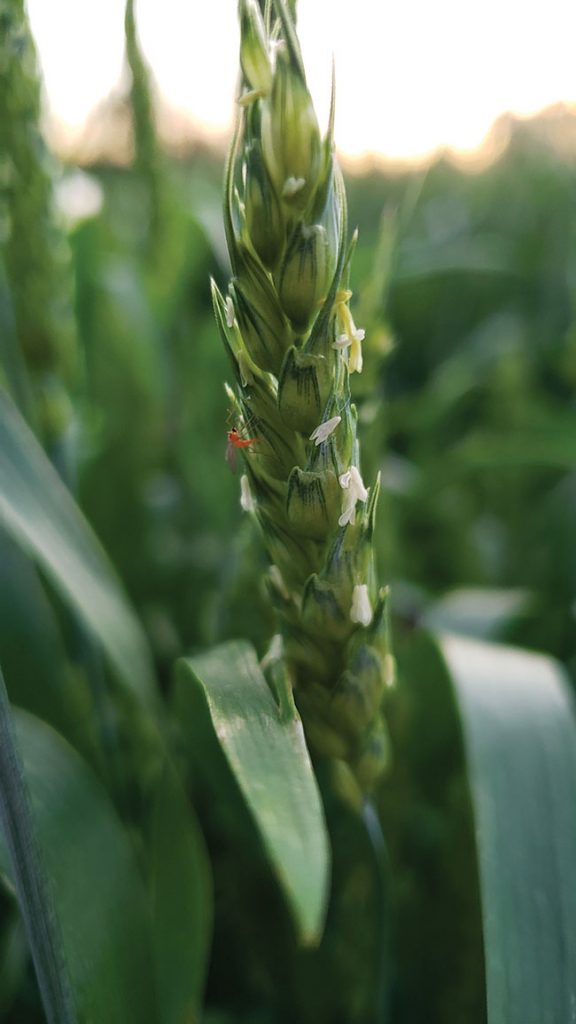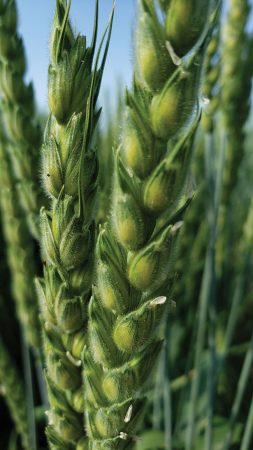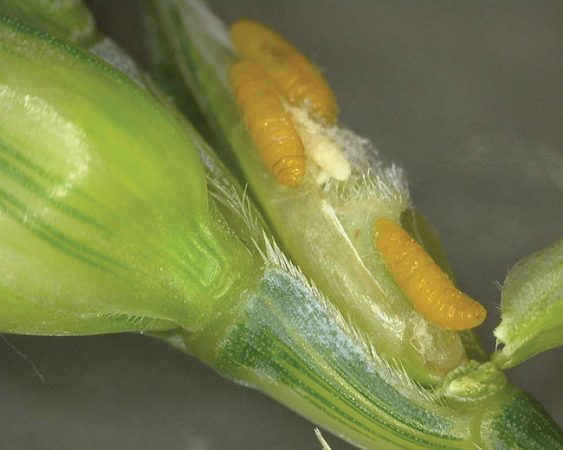
Features
Cereals
Insect Pests
Upping wheat’s defences against “the big bad”
Putting together multiple traits to fight the wheat midge.
May 18, 2021 By Carolyn King
 A wheat midge female searches for a place to lay her eggs on a spike of wheat. ALL Photos courtesy of Tyler Wist.
A wheat midge female searches for a place to lay her eggs on a spike of wheat. ALL Photos courtesy of Tyler Wist. Prairie researchers have teamed up to give spring wheat varieties multi-pronged defences against wheat midge attacks.
“I call the wheat midge one of the ‘big bads’ in wheat in Western Canada,” says Tyler Wist, a field crop entomologist with Agriculture and Agri-Food Canada (AAFC) in Saskatoon.
“Wheat midge populations have the potential to get really big, really fast under the right conditions. The larvae damage the wheat kernels, causing downgrading and yield losses. Very badly infested fields can have 90 per cent yield loss. If not controlled, the wheat midge could cause millions of dollars in losses each year for Prairie wheat production.”
At present, wheat midge-tolerant varieties are the main tool for controlling this potentially devastating pest. But these varieties all rely on a single gene, called Sm1, so there is an ongoing concern that the midge will evolve to defeat this gene.
A synchronized attack on wheat
“The wheat midge’s official common name is the orange wheat blossom midge. The adult is a small orange fly, about the size of a small mosquito. The females lay their eggs on wheat heads. The larvae hatch about five days later. They crawl down to the developing kernel and start feeding on everything that is coming into the kernel,” Wist explains.
“One larva can cause a wheat kernel to shrivel. Three to four larvae, which is pretty typical, will completely destroy a kernel.”
With August rain showers, the mature larvae drop to the ground. They snuggle into the moist soil and form overwintering cocoons. In the spring, once the soil receives about 25 millimetres of rain, the larvae crawl up to the surface, turn into pupae, and in a few days emerge as adults. There is only one generation per year.
“In our region, the midge is really well synchronized to the susceptible stages in our spring wheat, which are Zadoks stages 50 to 59. When spring wheat starts to head out, the adult midges are usually ready to emerge and lay eggs on the heads.”
The plant’s susceptibility to the midge drops off significantly once flowering (anthesis) starts. “In the anthesis and post-anthesis stages, the levels of a couple of acids in the seeds go up. The larvae don’t like those acids and they don’t feed very well on those seeds,” he explains.
“That is actually how the Sm1 gene works. It causes the plant to react to larval feeding by increasing the levels of those same two acids earlier than usual. So the larva stops feeding earlier and starves to death before it has a chance to do much damage.” This type of resistance to a pest is called antibiosis, meaning that the plant harms or kills the pest.
Current control options
“The Alberta and Saskatchewan agriculture ministries conduct wheat midge surveys every fall to forecast the risk for the coming year,” Wist notes. “If you are in a high-risk area, consider planting midge-tolerant wheat.”
Over 35 wheat midge-tolerant varieties are available at present, including most western Canadian spring wheat classes and durum, although the trait doesn’t work quite as well in durum. As a way to slow the development of “virulent” wheat midge
populations that have defeated Sm1, the Sm1 varieties are sold as blends, where 90 per cent of the seed in a bag is a midge-tolerant variety and 10 per cent is a midge-susceptible variety.
“Although there are no surveys looking for virulent wheat midges, I think we would know pretty quickly if a field of Sm1 wheat suffered serious midge damage,” Wist notes.
If the midges do eventually defeat Sm1, that would leave insecticides, crop rotation and a native parasitic wasp as the only tools for managing the pest. At present, dimethoate, an organophosphate, is the only available insecticide registered for wheat midge control, with chlorpyrifos on the way out.
Scouting to see if your crop is at the economic threshold for spraying and ensuring proper timing of spraying can both be a challenge. “The adult midges are only active around dawn and dusk. So, shortly before dusk each day when your crop is at Zadoks 50 to 59, you need to go to a few different spots in your field and count the number of these tiny flies flying around at canopy height,” Wist explains.
“The yield threshold is about one midge per five heads, and the grade threshold is about one midge per 10 heads. If you reach those thresholds, you have to take action pretty quickly because you can get a lot of crop damage in just a couple of nights, and the adults only live for about five days. Also, if you wait a little too long, your insecticide application will kill the parasitoid wasp that helps control the midge.”
Another defence: Smelly wheat
Wist is one of a group of Prairie researchers involved in two projects to develop more traits for fighting the wheat midge. Their goal is to pyramid these traits – stack them together with Sm1– in wheat varieties. This type of multi-layered defence would be much tougher for the midge to defeat, and all the individual traits to deter the midge would retain their effectiveness much longer.
Alejandro Costamagna, an entomologist at the University of Manitoba, is leading one of these projects, which is about oviposition deterrence (OD, egg-laying deterrence). This five-year Wheat Cluster project is funded by multiple agencies through the Canadian Agricultural Partnership.
Costamagna and Curt McCartney, a wheat geneticist and breeder now at the University of Manitoba, have been working on OD for a number of years. In some of their OD wheat lines, wheat midge egg-laying is reduced by over 60 per cent compared to susceptible plants.
Previous research showed that this deterrence is due to the plant’s odour – the chemical compounds that it releases into the air. The current project is investigating these compounds to better understand how the deterrence mechanism works in the plant and how the compounds affect the insect.
Wist, who is one of the collaborators on the project, says some of their preliminary findings suggest the OD wheat lines smell similar to post-anthesis wheat. “Since post-anthesis wheat is not very good for wheat midge larvae, our working hypothesis is that the female smells the oviposition-deterrent wheat, thinks it would not be good for her offspring, and decides not to lay eggs on it.”
As part of the project, McCartney is determining where the OD trait is located on the wheat genome and developing DNA markers for the trait. These markers will allow breeders to quickly screen the DNA of different wheat lines for the trait, rather than going through labour-intensive laboratory measurements to see what odour compounds the lines emit.

This hairy-glumed wheat is one of the SMART wheat lines being tested in the project to see how effective hairy glumes are in discouraging wheat midges.
Hairy, bristly barriers
Wist is leading the other project, which is looking at three other possible traits: awns, hairy glumes, and egg antibiosis. The Alberta Wheat Commission, Sask Wheat, Manitoba Crop Alliance, and Saskatchewan’s Agriculture Development Fund are funding the project.
“Awns and hairy glumes are possible mechanical deterrents to the midge. Awns are common on wheat, but hairy glumes are not. There is some evidence that awns might be a mechanical barrier to the midge landing on the wheat head. And some research shows that awns make it hard for aphids to land on wheat, which is another potential bonus. So we decided to include awns in our project. But our main focus is on hairy glumes,” he notes.
A glume is the covering around a spikelet on a wheat head. “The wheat midge female lands on the glumes and usually lays her eggs on them. To decide if it’s a good place to lay her eggs, she’ll probe the glume to pick up chemical cues. Our working hypothesis is that a hairy glume will interfere with her decision-making process and maybe even discourage landing on the plant, so perhaps she will not lay eggs on this hairy wheat.”
The hairy glume possibility came from Rob Graf, the AAFC winter wheat breeder at Lethbridge. A few years ago, he showed Wist a winter wheat line from a century ago that has really hairy glumes. Both Graf and Wist thought those hairs might deter wheat midges.
At that time, Graf had already crossed the hairy glume trait into spring wheat. For Wist’s project, Graf has bred a series of spring wheat lines: some lines have the awn trait, some have the hairy glume trait, some have Sm1, some have two of the traits, and some have all three. Graf is also continuing to cross the trait into other wheats.
“Rob and spring wheat breeder Harpinder Randhawa at AAFC-Lethbridge came up with an acronym for these lines: SMART wheat,” Wist notes. “The SM stands for Sitodiplosis mosellana, the scientific name for the midge, A is for Alternative, R for Resistance, and T for Triticum, the wheat genus.”
As well, Pierre Hucl, the wheat breeder at the University of Saskatchewan’s Crop Development Centre, has a hairy spring wheat line that he is providing for evaluation in the project. Wist says, “Pierre has near-isogenic lines of CDC Teal, which means they differ in just this one trait, so one near-isogenic line has hairy glumes and the other near-isogenic line does not.”

Three wheat midge larvae inside a wheat spikelet.
Killing the eggs
Wist learned about his project’s third trait from McCartney. AAFC researchers had discovered this trait a few years ago in a winter wheat breeding line. Preliminary tests on wheat plants with this trait suggested the female midge continued to lay her eggs on the heads but those eggs died before they hatched.
Wist is really intrigued by this trait because it might be better than Sm1 for preventing kernel damage. “The action of Sm1 kicks in when the wheat midge larva feeds on the grain. So even if the larva dies, that kernel sustains a little bit of damage. But with this other trait, which I’m calling egg antibiosis, the researchers found no larvae in those earlier experiments.”
McCartney has crossed the egg antibiosis trait into spring wheat lines, including some lines that have both egg antibiosis and Sm1. He is in the process of selection and crossing to improve the agronomic characteristics of the lines. And he is mapping the genes associated with egg antibiosis to create markers for the trait.
Towards multi-layered defences
Wist’s project team is conducting field and lab work, although COVID restrictions halted the lab work in 2020.
The field trials ran in 2019 and 2020 and will continue in 2021. The project team is evaluating the SMART lines, the CDC Teal lines and the egg antibiosis lines – hundreds of different lines in total – for things like agronomic performance, yield and wheat midge damage. The field evaluations are taking place at multiple sites: Hucl has four field sites in the Saskatoon area, Wist has one site at AAFC-Saskatoon, Graf has a site at Lethbridge, and McCartney has two Manitoba sites: one at Morden and one at Brandon in collaboration with AAFC wheat breeder Santosh Kumar. The grain samples from the plots are currently being analyzed in the lab to determine the degree of kernel damage from the pest.
“We’ve got some good wheat lines. For example, some of the SMART lines are beating the check by 6 to 8 per cent in yield. Interestingly, when we compared the different groups of the SMART lines, one thing that really stuck out was that the yield was highest when the plants had both awns and hairy glumes, whether or not the plants also had Sm1. So the high yields weren’t a function of Sm1; they were a function of having awns and hairy glumes,” Wist notes.
“That finding is very preliminary, but we might be onto something. Some research has shown that awns can increase photosynthesis, and perhaps the hairs on the glumes also do that. So perhaps the awns and hairs are helping to increase yield on their own, beyond the yield benefits from deterring the midge. But I’m totally speculating here.”
He adds, “To allow us to take a more in-depth look at the hairy glume trait, we are classifying the lines as: 0 – not hairy at all; 1 – moderately hairy; and 2 – really hairy. Our next task is to put them under a microscope and figure out what makes one plant hairier than another. Are the hairs longer? Are there more of them? Can we quantify that?”
So far, the results from the egg antibiosis lines suggest this trait is more effective when coupled with Sm1. Wist says, “We had about a dozen lines with both those traits at Brandon in 2019 with no wheat midge damage at all, whereas all the check lines did have damage.”
The project also involves lab bioassays in which the researchers can manage and closely observe the midge-plant interactions in a controlled environment. After being postponed in 2020, the bioassays are now underway, being conducted by Wist’s student Kristy Vavra and Costamagna’s student Bridget White. They are using the wheat midge colonies at AAFC-Saskatoon and the University of Manitoba to conduct the experiments.
These bioassays are critical for providing a more detailed understanding of the different defence mechanisms. For example, the team will be able to confirm whether or not the wheat midge eggs actually hatch on the egg antibiosis lines and to see how the female adults behave when they encounter hairy glumes or awns.
Wist emphasizes that the two wheat midge projects are only possible because wheat geneticists, wheat breeders and entomologists are all working together to find solutions to the “wheat midge scourge.” He is hopeful that this research will help advance the development of Prairie wheat varieties with multiple traits for repelling or killing the midge.
“Imagine if we get all these traits pyramided into a wheat plant. The oviposition deterrent trait makes the plant smell like something the midges don’t want to land on. Then if they do try to land on it, we’ve got awns and hairy glumes to get in their way, and maybe make them choose not to land or not to lay eggs. And if they do lay eggs, those eggs won’t hatch because of egg antibiosis. And we’ve got Sm1 in case any eggs hatch and the larvae start feeding.”